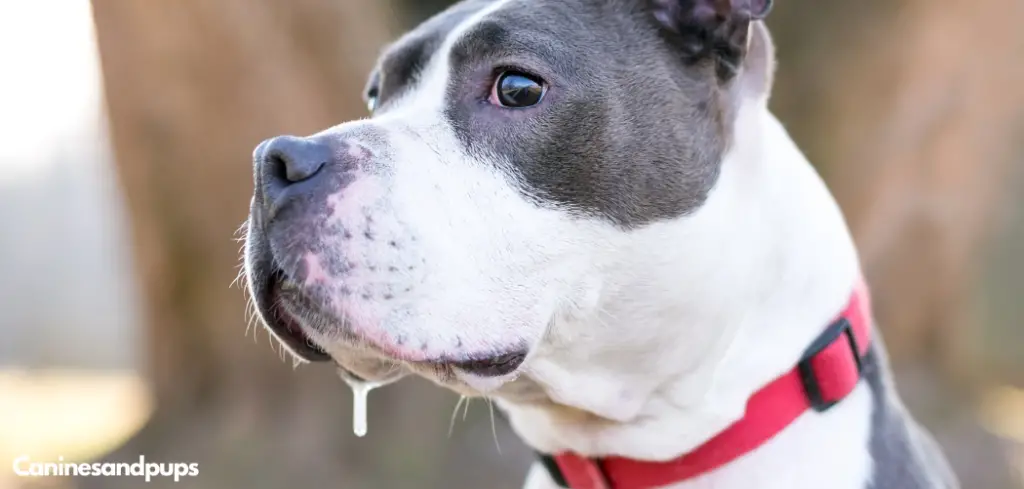Noticing your dog pooping blood and drooling can be alarming and is often a sign of serious gastrointestinal or systemic issues. These symptoms indicate that your dog may be experiencing digestive distress that requires attention.
We outline the common reasons your dog is pooping blood and drooling, what you can do at home, and when to seek veterinary help.
Table of Contents
Dog Pooping Blood and Drooling — Why It Happens
When a dog is pooping blood and drooling, it usually points to irritation or damage in the gastrointestinal tract. This can result from infections, parasites, dietary indiscretions, organ dysfunction, or toxin ingestion.
Drooling often accompanies nausea or discomfort, while blood in the stool signals bleeding within the intestines.
Prompt evaluation is important, as these combined symptoms can escalate quickly and indicate potentially life-threatening conditions.

Dog Pooping Blood and Drooling: Common Causes
Gastrointestinal Infections
Bacterial or viral infections, such as Salmonella, E. coli, or parvovirus, can damage the intestinal lining, leading to bloody stools and nausea-induced drooling.
Dogs may also show fever, lethargy, or loss of appetite. Rapid progression of infection, especially in puppies or older dogs, can become severe without timely intervention.
Read more: Dog Pooping Blood and Vomiting (What it could mean)
Parasite Infestations
Intestinal parasites like hookworms, whipworms, or roundworms can erode the gut lining, causing blood in the stool.
Drooling may occur as a response to nausea or abdominal discomfort. Puppies, unvaccinated dogs, or those with weak immune systems are particularly vulnerable. Untreated infestations can lead to anemia and malnutrition.
Dietary Indiscretion
Eating spoiled food, garbage, or unfamiliar treats can irritate the digestive system, leading to bloody stools and drooling due to nausea.
Owners may notice sudden vomiting, abdominal discomfort, or changes in behavior. While minor cases may resolve with fasting and bland diets, severe reactions require veterinary evaluation.
Inflammatory Bowel Disease (IBD)
IBD causes chronic inflammation of the intestines, producing recurrent episodes of bloody stool and excessive drooling.
Dogs may also exhibit weight loss, frequent diarrhea, or appetite changes.
Long-term management with veterinary guidance is essential to reduce flare-ups and prevent further intestinal damage.
Toxin Ingestion
Ingesting toxins, including certain plants, medications, or chemicals, can damage the gastrointestinal tract.
Blood in stool and drooling are early warning signs. Other symptoms may include vomiting, lethargy, tremors, or seizures. Prompt veterinary care is critical to prevent systemic complications and organ failure.
Gastric Ulcers
Ulcers erode the stomach or intestinal lining, sometimes causing blood in the stool and drooling from nausea.
Dogs may exhibit vomiting, loss of appetite, and signs of abdominal discomfort. Untreated ulcers can lead to severe internal bleeding and require medical intervention.
What to Do If Your Dog Is Dog Pooping Blood and Drooling
Ensure your dog has access to fresh water to prevent dehydration. Keep them comfortable in a quiet area and monitor their symptoms closely.
Temporarily withholding food may help settle the stomach, but avoid prolonged fasting without veterinary advice.
Introduce a bland diet, such as boiled chicken and rice, once vomiting has subsided. Record all observations, including stool appearance, frequency, drooling, and any changes in behavior, to provide detailed information to your veterinarian.
Avoid giving human medications or home remedies, as these can worsen the condition or interact with other health issues.
Maintain a calm environment and limit stressful activities, which can exacerbate gastrointestinal discomfort.
When to Call or Visit Your Vet
Seek immediate veterinary attention if your dog is a puppy, elderly, or has underlying health conditions.
Signs requiring urgent care include multiple episodes of bloody stool, persistent drooling, vomiting, lethargy, abdominal pain, or collapse. Sudden weakness, pale gums, or refusal to eat are also red flags.
Even if symptoms appear mild, the combination of blood in stool and drooling warrants prompt evaluation.
Early diagnosis and treatment can prevent severe complications, dehydration, or worsening of underlying diseases.
Read more: Dog Pooping Blood and Mucus Diarrhea (What it could mean for your dog’s health)
Key Takeaway
Dog pooping blood and drooling is a serious symptom that should not be ignored. Causes can range from infections, parasites, dietary issues, to ulcers or toxin ingestion.
Prompt veterinary care, supportive at-home measures, and careful monitoring are essential to ensure your dog’s health and aid in recovery.
